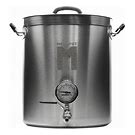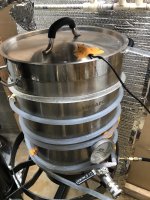robert.balsinger
Well-Known Member
I have been no chilling wort for the last half dozen beers and then corny fermenting the last three. I am ready to transfer cooled wort today. The thought occurred to me “Why not pitch to the covered BV and ferment then transfer to serving keg?” Basement is 66F and I have a cooling jacket to keep it there. There is little O2 in BV. What is there will be pushed out the lid the first 24 hrs. It has been covered since 5 min before I got ready to flame out. No O2 transfer will make a nearly zero O2 exposure. It is an 8 g MegaPot with thermometer and outlet. Easy to refractometer test a no O2 sample.
Gravity transfer to double purged keg. If it goes smoothly a couple times I could silicone gasket the lid, add some weight to the lid and make a ball lock port in the lid for capturing CO2 to purge keg.
Anyone done this before? I am sure some have. What could go wrong?
Gravity transfer to double purged keg. If it goes smoothly a couple times I could silicone gasket the lid, add some weight to the lid and make a ball lock port in the lid for capturing CO2 to purge keg.
Anyone done this before? I am sure some have. What could go wrong?



























![Craft A Brew - Safale S-04 Dry Yeast - Fermentis - English Ale Dry Yeast - For English and American Ales and Hard Apple Ciders - Ingredients for Home Brewing - Beer Making Supplies - [1 Pack]](https://m.media-amazon.com/images/I/41fVGNh6JfL._SL500_.jpg)

































